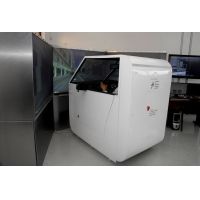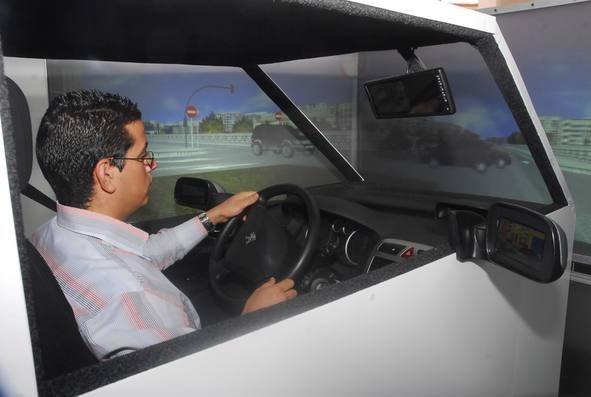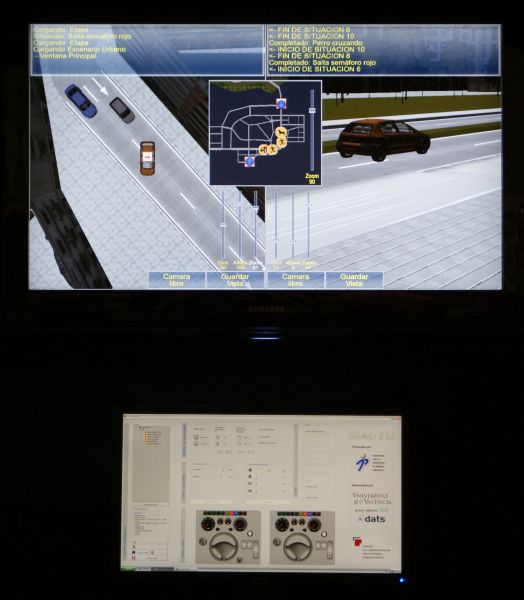Fundación de la Comunidad Valenciana para la prevención de riesgos laborales (Foundation of the Valencian Community for the prevention of occupational risks)
Design and construction of a car simulation system directed to carry out traffic occupational risks prevention courses, “in-itinere” and “on mission” accidents, in order to change the aptitudes and attitudes of the drivers who need it.
The complete architecture of the training room will be such that an instructor can control simultaneously two students, which can be divided as follows (in terms of physical components):
- A Post for the Instructor (PI).
- Two training Posts consisting of:
- Driving post.
- Projection system.
- PCs network.
A. Description of the structure (hardware).
Each of the simulation stations are in a real Peugeot’s car cabin and have a system of triple projection, a reconfigurable control panel, steering wheel with return power, driver’s seat, accelerator, brake and clutch pedals and manual and automatic gear change system.
Additionally, the driving post will require the following operations:
1. Sensorisation and Implementation. In order that, in general ,all the controls, indicators or other implementation equipment work like the real machine and to get the maximum degree of immersion in the cabin.
2. Sound system. The simulation cabin will have a sound system through which the sounds that provided the desire level of immersion will be reliably reproduced:
- Aerodynamic and rolling noise.
- Proper sounds of the cabin controls and indicators (indicators, horn, etc.).
- Proper sounds of weather conditions (rain, wind, etc.).
B. Description of the software and training system.
The provided software package is able to respond to the different configuration parameter groups:
- Initial state of the vehicle (vehicle model to be used, availability of the ABS system, ASR, fuel level, loading conditions, tire wear, etc.).
- Initial vehicle location (inter-urban scenario, mountain or urban, starting point, lane type).
- Type of pavement (firm asphalt with many/few/no irregularities with high/medium/low adherence).
- Traffic shaping (traffic density and average flow speed).
- Weather and visibility conditions (hour of the beginning of the test, factor of time acceleration, sun conditions, snow, rain, wind, fog).
In addition, during the definition of a test as an instructor, there is the possibility of including different kinds of events, specifically incidents, breakdowns and advanced functionalities of monitoring.
The instructor can influence on the simulation by adding online new events not included in the original definition of the test while developing as well as, providing some microscopic traffic control around the simulated vehicle.
Thus, in a simulation session events to test the driver’s abilities in situations that may happen on the road can be included.
Managed by the Fundación de la Comunidad Valenciana para la prevención de riesgos laborales, it is currently addressed at carrying out courses on traffic occupational risks prevention in the Valencian Community).
Made, with the funding of the Fundación para la Prevención de Riesgos Laborales (Foundation for Occupational Risks Prevention), by the Research Group DATS in collaboration with the Research Group ARTEC.
Development and innovation
Fundación de la Comunidad Valenciana para la prevención de riesgos laborales















